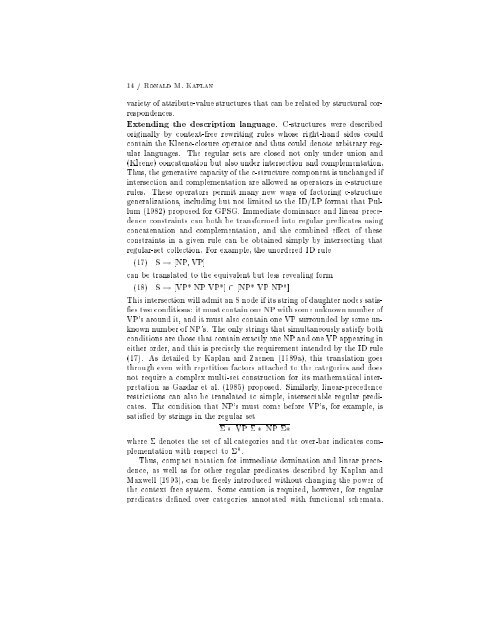The Formal Architecture of Lexical-Functional Grammar
The Formal Architecture of Lexical-Functional Grammar
The Formal Architecture of Lexical-Functional Grammar
You also want an ePaper? Increase the reach of your titles
YUMPU automatically turns print PDFs into web optimized ePapers that Google loves.
14 /Ronald M. Kaplan<br />
variety <strong>of</strong> attribute-value structures that can be related by structural correspondences.<br />
Extending the description language. C-structures were described<br />
originally by context-free rewriting rules whose right-hand sides could<br />
contain the Kleene-closure operator and thus could denote arbitrary regular<br />
languages. <strong>The</strong> regular sets are closed not only under union and<br />
(Kleene) concatenation but also under intersection and complementation.<br />
Thus, the generative capacity <strong>of</strong> the c-structure componentisunchanged if<br />
intersection and complementation are allowed as operators in c-structure<br />
rules. <strong>The</strong>se operators permit many new ways <strong>of</strong> factoring c-structure<br />
generalizations, including but not limited to the ID/LP format that Pullum<br />
(1982) proposed for GPSG. Immediate dominance and linear precedence<br />
constraints can both be transformed into regular predicates using<br />
concatenation and complementation, and the combined e ect <strong>of</strong> these<br />
constraints in a given rule can be obtained simply by intersecting that<br />
regular-set collection. For example, the unordered ID rule<br />
(17) S ! [NP, VP]<br />
can be translated to the equivalent but less revealing form<br />
(18) S ! [VP* NP VP*] \ [NP* VP NP*]<br />
This intersection will admit an S node if its string <strong>of</strong> daughter nodes satises<br />
two conditions: it must contain one NP with some unknown number <strong>of</strong><br />
VP's around it, and it must also contain one VP surrounded by some unknown<br />
number <strong>of</strong> NP's. <strong>The</strong> only strings that simultaneously satisfy both<br />
conditions are those that contain exactly one NP and one VP appearing in<br />
either order, and this is precisely the requirement intended by the ID rule<br />
(17). As detailed by Kaplan and Zaenen (1989a), this translation goes<br />
through even with repetition factors attached to the categories and does<br />
not require a complex multi-set construction for its mathematical interpretation<br />
as Gazdar et al. (1985) proposed. Similarly, linear-precedence<br />
restrictions can also be translated to simple, intersectable regular predicates.<br />
<strong>The</strong> condition that NP's must come before VP's, for example, is<br />
satis ed by strings in the regular set<br />
VP NP<br />
where denotes the set <strong>of</strong> all categories and the over-bar indicates complementation<br />
with respect to *.<br />
Thus, compact notation for immediate domination and linear precedence,<br />
as well as for other regular predicates described by Kaplan and<br />
Maxwell (1993), can be freely introduced without changing the power <strong>of</strong><br />
the context free system. Some caution is required, however, for regular<br />
predicates de ned over categories annotated with functional schemata.

















